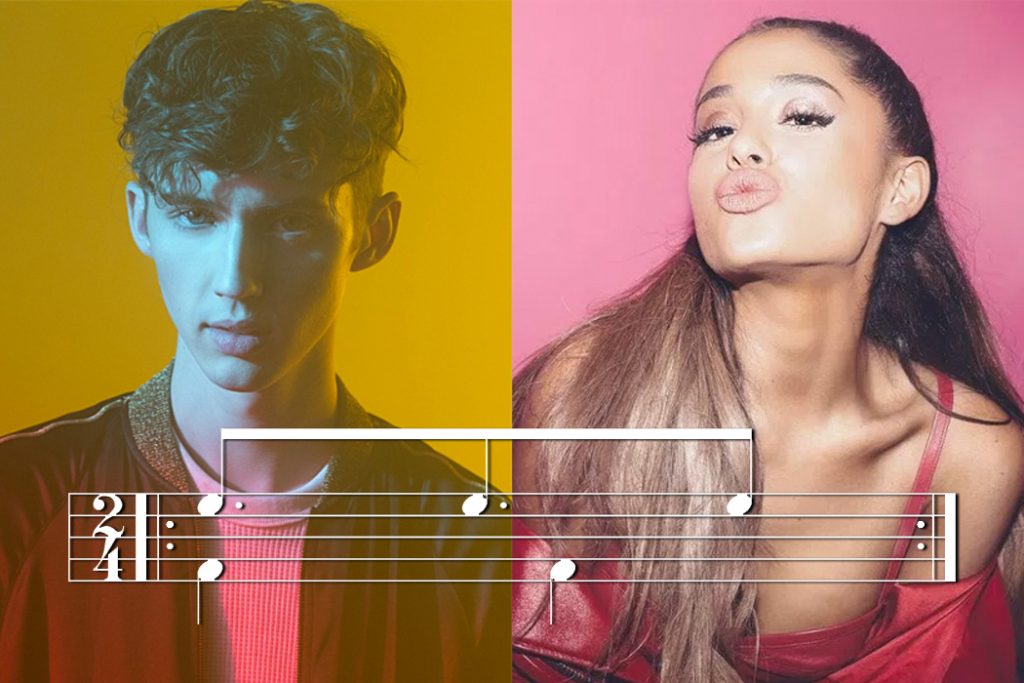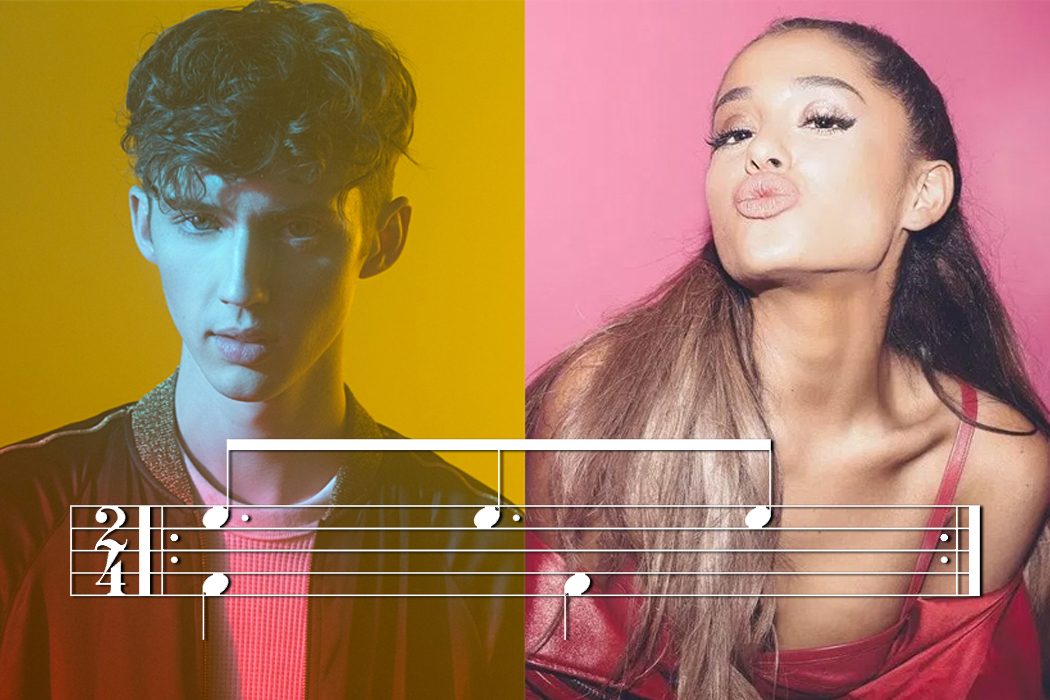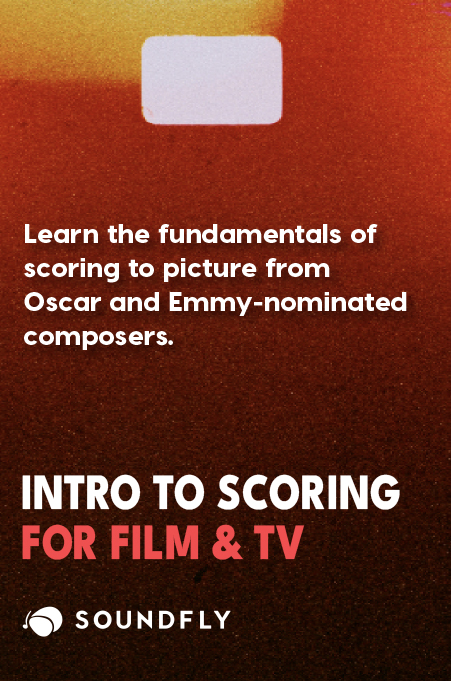+ Welcome to Soundfly! We help curious musicians meet their goals with creative online courses. Whatever you want to learn, whenever you need to learn it. Subscribe now to start learning on the ’Fly.
YouTube sensation and new-heartthrob-on-the-block Troye Sivan just dropped his new single, “Dance to This,” which features guest vocals by Ariana Grande. Yes, this song is destined to be the mellow, emotional dance hit of the summer, but don’t dismiss it just yet — there’s some interesting bologna in this musical sandwich.
Take a listen!
Let’s start with the basics.
What’s going on with the harmony?
“Dance to This” is in the key of G# minor. Yes, G# minor, not A♭ minor. Sorry, horn players, we’re using the sharp key to favor G# minor’s much more desirable relative major scale: B (as opposed to the C♭ major of A♭).
This also follows a trendy pattern charted by Dean Olivet in his article that dissects the 40 songs that cracked the Billboard Top 5 in 2017. In it, he discovered a sharp decline (pun intended) in the number of hit songs written in keys such as E, A, D, and G. This is one of the results of the lack of the guitar as a prominent and driving force in the recording process.
That might hurt the guitarists here a little bit to read, but honestly, listening to songs in those keys grows tiring and boring eventually, anyway. And even though I’m a guitarist myself, I did work this analysis out on the piano, so I can’t preach.
The chord progression remains the same throughout the piece, and contains some subtle but pleasant extensions, especially if we factor in the color tones taken from the melody, which we’ll break down shortly. For now, here are the basic chord changes we have throughout the song.

IV– ♭VII I– ♭VI
The song begins on the IV– chord, C#m, and doesn’t resolve to the root of G#m until the third chord of the progression.
In the intro, we’re given a nice descending melody that is played on a synthesizer and guitar in tandem. Here it is written out, and below I’ve provided an isolated audio track of just the melody.

Using notes implied from the melody, we can construct more complete chord changes by using the melody to add extensions into our accompaniment. So let’s augment the chords with some extra color notes and discover the voice leading possibilities happening on the page itself.

The 9th in the C#m chord and the 6th in the F# chord are both the note D#. Since the melodic motif of the intro anchors us with that D# in a higher octave, it feels very smooth, very natural as a chord extension. Therefore, we can use it as a color tone, and to create pleasant voice leading during the first two bars.
When it comes to the third chord in the progression (the root of the key in this case), instead of G#m, we can use extensions to recreate it as G#m7(9).
Going back to the melodic motif in the introduction, the line that the guitar plays contains the notes B, F#, A#, D#, and G#, all of which belong to the G#m7(9) chord. The melody here is practically spelled out for us (pun intended again).
And for our final chord in this progression, E, we can add a 9th to make it an E9 chord, using the note F#, since that note was just referenced in the G#m7(9) and it makes an easy transition. Remember, using more common tones and less lateral movement creates smooth transitions between chords. Also, that F# is the 7th scale degree in our key, so it naturally leads us back up to the root. Even though we don’t go back to the I– chord at the beginning of the progression, G# does appear in the triad of the first chord, C# minor.
Listen to these new extended chords with the melody joined back in.
Now that we’ve dissected the chord progression and the song’s melodic identity, we can experiment a little bit with reharmonizing it to take these colors to different shades in the spectrum of emotion. In the interest of pushing the boundaries of what pop music can be, and honoring thine old-time tradition of jazz musicians manipulating the hits of the day to maniacal ends, I reharmonized the opening motif with techniques like tri-tone substitution, modal interchange, and chromatic bass lines (many of which we touch on in our popular online course, The Creative Power of Advanced Harmony).

Listen to the reharmonized chord progression here.
And now, here it is together with the melodic motif back in.
Alright, enough of that — let’s examine the song’s rhythmic structure!
That Afro-Cuban polyrhythm we can’t live without!
The groove that enters “Dance to This” at 0:09 along with the verse is a driving and very (evidently) danceable pseudo-Latin rhythm based on a tresillo, or “triplet” in Spanish, as described in Cuban music culture. In Cuban music, a tresillo serves as the “three-side” of a son clave. Here’s the full son clave rhythm for reference.

This quintessential Afro-Cuban rhythm permeates a huge array of Sub-Saharan and South Asian music, and was carried over by enslaved peoples to the shores of what is now Central America and the Caribbean as a result of the Atlantic Slave Trade.
However, the tresillo itself is slightly different from what we know as the “triplet” in traditional Western notation. Here’s a classic triplet, so we can see the difference:
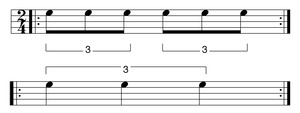
Although the beat in “Dance to This” isn’t a true Cuban rhythm (it’s only half of the son clave pattern, after all), we can try imposing a 2/3 or 3/2 clave over the beat as an exercise in feeling the polyrhythm within. Go ahead and clap along to “Dance to This,” using each of these two rhythms, to see which of the two sounds best to you.
I personally prefer the 3/2 clave here, as the first bar aligns nicely with the rhythm found in the kick, starting right on beat one.
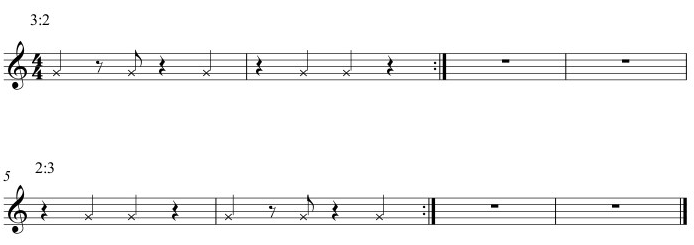
In “Dance to This,” we have an example of a three-beat pattern of equal note values that is cut off by each repeating phrase. This is created by the dotted-eighth-note pattern on the kick drum against a duple meter pulse. The three kick drums starting from beat one are each separated by a distance of a dotted-eighth note. It’s just like the “three” side of the clave rhythm, but twice as fast.

In this rhythm lies arguably the most basic polyrhythmic idea available to us, with a 3:2 ratio. The underlying subdivision in this polyrhythm unit is a single sixteenth note, and each kick drum hit represents three subdivisions. But then, with a space of only two sixteenth notes after the third kick drum, the three-over-four feeling is cut off, as the pattern repeats.

If the full son clave pattern were to play out, the second measure would begin with a rest, therefore allowing the third beat of our pulsating tresillo more space. But that doesn’t happen, so we’re brought back up to the top of the pattern with every measure.
The ear is torn between feeling the consistent pattern of the kick playing a pulse in intervals of three sixteenth notes at a time, while the basic quarter-note beat that comes from the 4/4 time signature pulls at a faster pulse of two sixteenth notes at a time. Many dance, pop, and EDM tracks these days play with this basic polyrhythmic figure, using various numbers of dotted-eighths in a wild polyrhythmic circle until the two rhythms finally realign (it works for Beebs!).
And this tresillo is why a lot of pop music today sounds like it has that Afro-Cuban influence flowing through it.
In this case, Troye Sivan’s pop-production crew settled with scraping the tip of the polyrhythmic iceberg here. But this particular polyrhythm digs deep into the fabric of Afro-Cuban musical roots as we know it, and it’s always fun to chart the influence of Western pop when it so tidily comes from non-Western sources. This rhythm in particular is ancient, and all of us can find a way to resonate with it — you basically can’t help but dance to it when you hear it.
As such, it’s what gives this tune some playful finesse, without over-complicating the song’s mission to be the smash hit of the summer.
Want to get all of Soundfly’s premium online courses for a low monthly cost?
Subscribe to get unlimited access to all of our course content, an invitation to join our members-only Slack community forum, exclusive perks from partner brands, and massive discounts on personalized mentor sessions for guided learning. Learn what you want, whenever you want, with total freedom.
